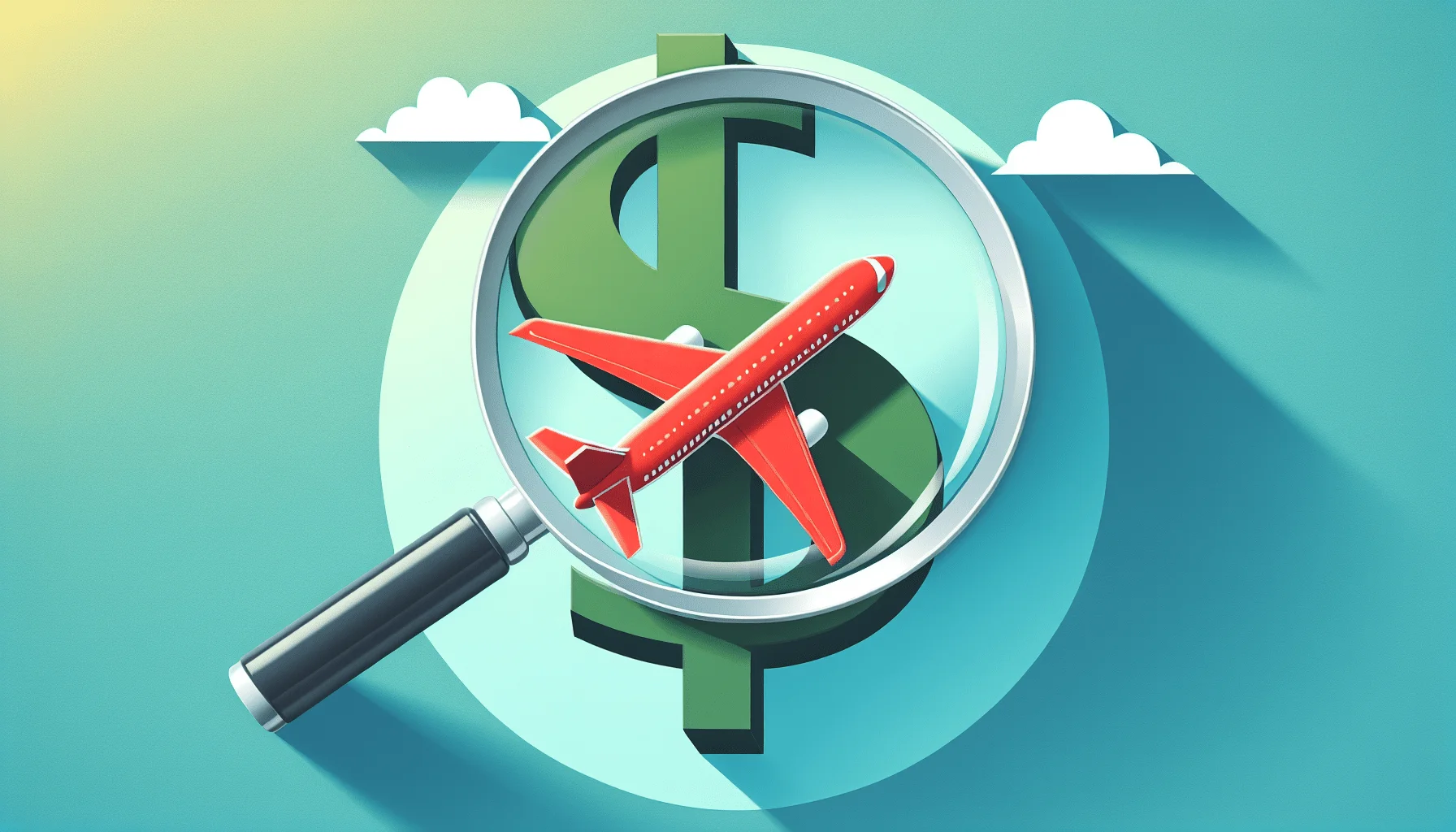The Ultimate Guide To Booking Cheap Flights
Planning your next vacation doesn’t have to break the bank – with “The Ultimate Guide to Booking Cheap Flights,” you’ll discover all the insider tips and tricks to scoring the best deals on airfare. Whether you’re jetting off for a weekend getaway or embarking on a globetrotting adventure, this comprehensive guide is your go-to resource for finding affordable flights. From secret booking hacks to budget-friendly airlines, get ready to take off without emptying your wallet.
Understanding Peak and Off-Peak Travel Seasons
Identifying peak travel periods
When planning your next trip, it is important to consider the concept of peak and off-peak travel seasons. Peak travel periods are the times of the year when travel demand is at its highest, usually coinciding with major holidays and school breaks. These periods are characterized by crowded airports, higher prices, and limited availability. On the other hand, off-peak travel seasons refer to the times of the year when travel demand is low, resulting in lower prices and more flight options.
To identify peak travel periods, it’s essential to consider factors such as public holidays, school breaks, and popular tourist destinations. Some examples of peak travel periods include summer vacation months, winter holidays, and long weekends. By being aware of these peak travel periods, you can better plan your trips and avoid the hassles associated with crowded airports and inflated prices.
Benefits of off-peak travel
Opting for off-peak travel seasons can offer several benefits. Firstly, you can expect to find lower airfare prices, as airlines tend to lower their rates during periods of low demand. Secondly, airports and popular tourist destinations are less crowded, making your travel experience more relaxed and enjoyable. Additionally, accommodations and attractions often offer discounts during these periods, allowing you to save even more money. Lastly, off-peak travel seasons provide an opportunity to immerse yourself in the local culture and experience less crowded attractions, providing a more authentic travel experience.
Effects of travel seasons on flight prices
Flight prices are heavily influenced by travel seasons. During peak periods, airlines increase their ticket prices due to high demand. This means that if you plan to travel during popular holidays or school breaks, you can expect to pay a premium for your flights. On the other hand, off-peak travel seasons offer the advantage of lower flight prices. Airlines often reduce their fares during these periods to attract more travelers. By understanding the effects of travel seasons on flight prices, you can make more informed decisions when booking your flights and potentially save a significant amount of money.
Researching Airlines and Flight Aggregators
Comparison between traditional and budget airlines
When it comes to booking flights, you’ll encounter both traditional and budget airlines. Traditional airlines, often referred to as legacy carriers, are typically full-service airlines offering a range of amenities, such as complimentary meals, larger seat sizes, and more extensive flight networks. However, these airlines tend to have higher fares due to the added services they provide.
On the other hand, budget airlines, also known as low-cost carriers, offer affordable fares by adopting a no-frills approach. These airlines often charge extra fees for services such as checked baggage and seat selection, and they may operate from secondary airports. While budget airlines have a reputation for lower prices, it’s essential to carefully consider the additional fees and services offered when comparing prices.
Understanding flight aggregators
Flight aggregators are online platforms that allow travelers to compare and book flights from multiple airlines in one place. These platforms aggregate flight information from various sources, making it easier for users to find the best deals. They provide a comprehensive overview of flight options, allowing you to filter and sort by price, airline, and other preferences.
Flight aggregators not only save you time and effort but also enable you to find the most cost-effective flights. By comparing prices across multiple airlines and dates, you can make informed decisions and secure the best deal.
Choosing the best flight comparison websites
With numerous flight comparison websites available, selecting the right one can be overwhelming. It is crucial to consider factors such as user reviews, ease of use, and the breadth of flight options. Some popular flight comparison websites include Skyscanner, Kayak, and Google Flights. These websites provide extensive search capabilities, user-friendly interfaces, and reliable results.
When choosing a flight comparison website, make sure to read reviews and consider the specific features that are essential to your travel needs. It’s also a good idea to sign up for email alerts or newsletters from these websites to stay updated on the latest flight deals and promotions.
Advanced Search on Flight Comparison Websites
Searching for the cheapest day to fly
If you want to find the cheapest flights, it’s worth experimenting with different departure and return dates. Flight prices can vary significantly depending on the day of the week and the time of the year. Generally, midweek flights tend to be cheaper than those on weekends, as business travelers typically prefer weekdays.
To find the cheapest day to fly, use the flexible date search option on flight comparison websites. This feature allows you to view prices for a range of departure and return dates, giving you a clear picture of the most cost-effective options. By adjusting your travel dates, you can potentially save a significant amount on your flight expenses.
Seasonal flight price fluctuations
It’s important to understand that flight prices can fluctuate significantly throughout the year. Airlines adjust their prices based on factors such as seasonality, demand, and competition. For example, flights during peak travel seasons like summer and Christmas tend to be more expensive compared to off-peak months.
To stay informed about seasonal flight price fluctuations, utilize the price alerts feature on flight comparison websites. By setting price alerts for your desired destinations and travel dates, you will receive notifications when prices drop or increase, allowing you to book at the most opportune moment.
Effect of time of booking on flight prices
The timing of your flight booking can significantly impact the price you pay. Generally, the earlier you book, the more likely you are to secure lower prices. Airlines often offer their cheapest fares several months in advance, gradually increasing prices closer to the departure date.
To ensure you get the best possible deal, consider booking your flight well in advance. While last-minute deals may sometimes be available, relying on this approach can be risky and may result in higher prices. By planning ahead and booking in advance, you have a higher chance of finding affordable flights.
Significance of Flexibility in Travel Dates
How flexible travel dates can reduce costs
One of the most effective ways to reduce flight costs is by being flexible with your travel dates. If you have the flexibility to adjust your departure and return dates, you can take advantage of lower prices that may be available on certain days. This is particularly useful when searching for flights during off-peak travel seasons or when booking well in advance.
By being flexible, you can potentially save a significant amount of money on your flights. This extra flexibility also allows you to plan your trip around the cheapest options available, enabling you to maximize your travel budget.
Tools to find the cheapest travel dates
To find the cheapest travel dates, utilize the “flexible dates” feature on flight comparison websites. This feature allows you to view a range of prices for different departure and return dates, giving you a clear picture of the cheapest options available. Some websites even offer “cheapest month” search options, which provide an overview of the lowest fares for an entire month.
Additionally, there are specialized websites and apps that focus on finding the cheapest travel dates. These tools analyze historical flight data and trends to help you identify the most affordable time to travel. By utilizing these tools, you can maximize your chances of finding the best deals and saving money on your flights.
Difference in price for weekday and weekend flights
When it comes to flight prices, there is often a significant difference between weekday and weekend flights. Weekday flights, especially those on Tuesday and Wednesday, tend to be cheaper due to lower demand. Conversely, weekend flights, particularly those on Fridays and Sundays, are generally more expensive as they cater to leisure travelers.
To save money on your flights, consider booking weekday flights rather than weekend ones. By being flexible and adjusting your travel dates accordingly, you can take advantage of lower fares and reduce your overall travel expenses.
Booking Flights in Incognito Mode
Reasons for price changes during repeated searches
Have you ever noticed that flight prices often increase after repeated searches? This phenomenon occurs due to various factors, including dynamic pricing algorithms used by airlines and cookies stored on your browser. Airlines track user behavior and adjust prices based on demand and perceived purchase urgency.
When you search for flights multiple times, airlines may interpret this as increased demand and raise prices accordingly. This can be frustrating when trying to find the best deal, but there is a solution: booking flights in incognito mode.
How incognito mode helps in getting cheaper flights
When you browse in incognito mode, your browsing history and cookies are not saved, preventing airlines from tracking your search behavior. By booking flights in incognito mode, airlines are unable to raise prices based on your repeated searches, giving you a fairer chance at finding cheaper flights.
To use incognito mode, open a new private browsing window on your web browser. This mode ensures that your search activity remains private and helps you avoid potential price increases caused by repeated searches.
Step-by-step guide to use incognito mode
- Open your web browser (such as Google Chrome, Mozilla Firefox, or Safari).
- Locate the settings or options menu in your browser.
- Select “New Incognito Window” or a similar option from the menu.
- A new incognito window will open, indicated by a private browsing icon
- Now, you can use this incognito window to search for flights without the risk of price increases associated with repeated searches.
- Remember to close the incognito window after you have completed your flight search.
By following these steps, you can take advantage of incognito mode to potentially find cheaper flights and avoid any unwanted price increases caused by repeated searches.
Utilizing Frequent Flyer Programs and Travel Reward Cards
Overview of frequent flyer programs
Frequent flyer programs, also known as airline loyalty programs, are designed to reward regular customers with various benefits and perks. These programs allow you to earn points or miles for each flight you take, which can then be redeemed for discounted or free flights, upgrades, and other travel-related rewards.
When choosing an airline, consider the frequent flyer programs they offer and the potential benefits you can accrue. Signing up for these programs is usually free, and they can provide significant savings and additional comforts for frequent travelers.
Benefits of travel reward credit cards
In addition to frequent flyer programs, travel reward credit cards offer a way to earn extra points or miles on everyday spending. These credit cards are affiliated with specific airlines or hotel chains and provide additional benefits such as sign-up bonuses, access to airport lounges, and priority boarding.
Travel reward credit cards can help you accumulate points or miles more quickly, allowing you to enjoy the benefits of frequent flyer programs sooner. Before choosing a travel reward credit card, compare the benefits and fees associated with different cards to find the one that aligns with your travel preferences and goals.
Maximizing discounts through loyalty programs
To maximize your discounts and rewards through loyalty programs, it’s important to stay engaged with the airline or credit card provider. Regularly monitor your account for promotions or special offers, and take advantage of any opportunities to earn bonus points or miles.
Furthermore, consider maintaining loyalty to a specific airline or alliance to consolidate your travel rewards. By flying with a certain airline or its partners and using their affiliated credit card, you can consolidate your rewards to earn more significant benefits. This strategic approach to loyalty programs can result in substantial savings and enhanced travel experiences.
Importance of Booking Early
Best time to book international and domestic flights
Booking flights early is generally recommended to secure the best prices and availability. The ideal time to book can vary depending on whether you are considering international or domestic flights.
For international flights, it is generally advised to book between three to six months in advance. This allows you to take advantage of early bird deals and ensures you have a wide selection of flight options. On the other hand, domestic flights can often be booked closer to the departure date, with a recommended booking window of one to three months in advance.
While these guidelines provide a general rule of thumb, it’s important to monitor flight prices and availability regularly. Airlines may occasionally offer last-minute sales or promotions that can provide significant savings, so it’s always worth staying alert for any opportunities to book at discounted rates.
Risks of last-minute booking
While last-minute booking can sometimes result in significant savings, it can also be risky. The availability of seats becomes more limited, and prices tend to increase as the departure date approaches. This is particularly true during peak travel seasons when demand is high.
By booking flights in advance, you not only secure better prices but also have a wider selection of seat options and flight times. Additionally, booking early allows you to plan the rest of your trip with peace of mind, knowing that your flights are taken care of.
Understanding airline pricing strategies
Airlines use dynamic pricing strategies to maximize their revenue while filling their planes to capacity. These strategies involve adjusting prices based on a variety of factors, such as demand, competition, and the time of booking. Understanding these pricing strategies can help you make more informed decisions when booking flights.
One common strategy airlines employ is yield management, where prices fluctuate based on demand. As more seats are sold and the departure date approaches, prices tend to increase. Airlines also engage in price differentiation, offering different fares for different classes, such as economy, premium economy, business, and first class.
To navigate these pricing strategies, it’s essential to research and compare prices across multiple airlines and booking platforms. By being aware of how prices fluctuate, you can identify the best times to book and secure the most affordable flights.
Considering Alternate Airports and Indirect Flights
Costs and benefits of flying into alternate airports
When planning your trip, it’s worth considering flying into alternate airports instead of the most popular or primary airports. Alternate airports, also known as secondary or regional airports, are often located in smaller cities or regions near major cities. While they may require additional travel time to reach your final destination, they can offer significant cost savings.
Flying into alternate airports can result in lower flight prices and reduced congestion, as these airports generally have lower operational costs for airlines. Additionally, parking fees and transportation options may be more affordable at these airports. However, it’s essential to consider the overall cost and convenience of traveling from the alternate airport to your final destination before making a decision.
Price difference between direct and indirect flights
When booking flights, you will typically encounter two types of routes: direct and indirect flights. Direct flights take you from your origin to your destination without any layovers, while indirect flights involve a layover at an intermediate airport.
Direct flights are often preferred due to their convenience and shorter travel times. However, they tend to be more expensive compared to indirect flights. If you are willing to tolerate a layover, choosing an indirect flight can offer substantial savings. Layovers are particularly beneficial when flying internationally, as they can include brief stops at major transit hubs, allowing you to explore additional destinations along the way.
When considering indirect flights, ensure you have sufficient time for your layovers and consider factors such as airport amenities and transfer options to make your journey as smooth as possible.
How layovers can save money
Layovers, although sometimes seen as inconvenient, can be an opportunity to save money and explore new destinations. Some airlines offer free or low-cost stopovers, allowing you to spend a day or more in the layover city before continuing to your final destination.
By taking advantage of these stopover options, you can turn a layover into a mini vacation. This not only provides an opportunity to explore a new city but also allows you to break up a long journey and potentially save money on accommodation and transportation costs.
Evaluating Hidden Fees and Extra Charges
Reading the fine print before booking
Before finalizing your flight booking, it is crucial to read the fine print and understand any potential hidden fees and extra charges. These fees can significantly impact the overall cost of your flight and may not always be immediately apparent when searching for flights.
Common hidden fees include charges for checked baggage, seat selection, meals, and even printing boarding passes at the airport. Some low-cost airlines might also charge for priority boarding, in-flight entertainment, and other services that are typically included in full-service carriers.
By carefully reviewing the terms and conditions and understanding the fee structure of each airline, you can make more informed decisions and avoid any surprises when it comes to additional charges.
Costs for checked baggage, seat selection, and meals
Checked baggage fees are a common extra charge levied by airlines. Many carriers offer a certain weight or size allowance for free, but exceeding these limits can result in additional fees. It’s important to consider your luggage needs and familiarize yourself with the baggage policies of your chosen airline before booking.
Similarly, some airlines charge extra for seat selection, especially for preferred seats with additional legroom or in specific areas of the plane, such as exit rows. While basic seat assignments are typically provided for free, if you have specific preferences, it’s important to weigh the cost of seat selection against the benefits it provides.
Lastly, airlines may charge for in-flight meals or snacks, particularly on shorter flights or low-cost carriers. If you prefer to have a meal onboard, consider checking the airline’s offerings and prices in advance. Alternatively, you can also bring your own snacks or purchase food at the airport before boarding to save money.
Avoiding unnecessary fees
To avoid unnecessary fees, it’s essential to plan and prepare accordingly. Take the time to carefully pack, ensuring your baggage complies with the airline’s size and weight restrictions. Consider traveling with a carry-on bag only, as many airlines allow this without additional fees.
If seat selection is important to you, it’s advisable to check-in online as early as possible, as this is often when free seat assignments are made available. By securing your desired seat during online check-in, you can avoid potential charges for seat selection.
As for in-flight meals, consider bringing your own snacks or purchasing food at the airport before your flight. This way, you can enjoy a cost-effective meal without having to pay for inflight catering.
Staying Alert for Flight Deals and Discounts
Subscribing to airline newsletters for promos
Airlines frequently offer exclusive promotions and discounts to subscribers of their newsletters. By subscribing to airline newsletters, you can stay informed about upcoming sales, special offers, and limited-time promotions. This gives you the opportunity to secure discounted flights and potentially save a significant amount of money.
When signing up for airline newsletters, consider creating a separate email account specifically for travel-related subscriptions. This way, you can keep all your travel offers in one place, making it easier to review and take advantage of any deals that come your way.
Using mobile apps for deal notifications
In addition to subscribing to airline newsletters, using mobile apps can be a convenient way to receive deal notifications and stay updated on the latest flight offers. Many airlines have their own mobile apps, which allow you to search for flights, manage bookings, and receive personalized notifications.
Additionally, there are third-party apps and aggregators that specialize in finding and notifying users about flight deals. These apps often provide real-time updates on discounted fares and exclusive promotions from various airlines and travel providers.
By utilizing these mobile apps, you can gain immediate access to flight deals and discounts and make informed decisions about booking your next trip.
Participating in flash sales and error fare promotions
Flash sales and error fares are another way to secure heavily discounted flights. Flash sales are short-term promotions offered by airlines, typically lasting only a few hours or days. These sales often feature significantly reduced fares for specific routes or travel periods.
Error fares, also known as mistake fares, occur when airlines unintentionally publish incorrect ticket prices due to technical errors or glitches. These fares can be significantly lower than the regular prices and provide an opportunity for massive savings. However, it’s important to note that airlines have the right to cancel error fares, so it’s essential to confirm your booking and make any necessary accommodations only after the airline has confirmed your ticket.
To be alerted about flash sales and error fares, consider following airlines and travel deal websites on social media platforms and signing up for their email newsletters. This way, you can be among the first to know about any promotions and take advantage of the discounted fares before they sell out.
In conclusion, understanding peak and off-peak travel seasons, researching airlines and flight aggregators, utilizing advanced search features, considering flexibility in travel dates, booking flights in incognito mode, utilizing frequent flyer programs and travel reward cards, booking early, considering alternate airports and indirect flights, evaluating hidden fees and extra charges, and staying alert for flight deals and discounts can all contribute to finding and booking cheap flights. By applying these strategies and being diligent in your search, you can save money on your flights and make your travel dreams a reality.







